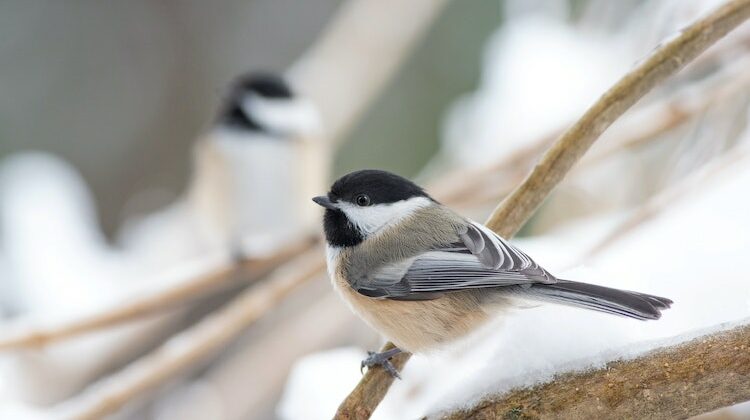
Are you wondering “what birds are in my backyard in Minnesota”? Being aware of which Minnesota birds you can expect in your backyard makes identifying the different species much quicker and easier. Familiarise yourself with the images and descriptions in this article and you’ll become an expert on the most common birds native to Minnesota backyards through the year. We have compiled this list of common backyard birds in Minnesota from citizen sightings reported on eBird, and added some tips for attracting birds to your backyard.
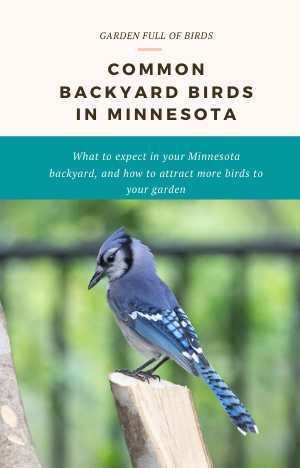
Most Common Backyard Birds in Minnesota In Summer
If you are bird watching in Minnesota during the months of May to July, those are the birds you can expect to see in your backyard more often.
- American Robin (51%)
- Song Sparrow (44%)
- American Goldfinch (41%)
- American Crow (37%)
- Black-capped Chickadee (34%)
- Chipping Sparrow (28%)
- Mourning Dove (27%)
- Blue Jay (26%)
- Common Grackle (25%)
- House Wren (24%)
- Barn Swallow (24%)
- Gray Catbird (23%)
- Northern Cardinal (23%)
- Red-eyed Vireo (22%)
Most Common Backyard Birds in Minnesota In Winter
During the Winter months (December to February or Early March) the most common birds visiting Minnesota backyards are:
- Black-capped Chickadee (53%)
- American Crow (41%)
- Downy Woodpecker (33%)
- White-breasted Nuthatch (29%)
- Blue Jay (26%)
- Hairy Woodpecker (23%)
- Dark-eyed Junco (21%)
- Northern Cardinal (20%)
The number in between parenthesis are the frequencies at which those birds are sighted by regular everyday bird watchers in the Minnesota region. You can still see many of the winter Minnesota birds during spring and summer, but some species take over as the most popular over the summer months.
American Robin (Turdus Migratorius)

This bird is a popular sign marking the end of winter, and you can see their orange-red chest feathers at the beginning of Minnesota Spring. They migrate north for breeding, and go south in the winter. They love eating worms and are frequent visitors to well stocked feeders. Breeding pairs will love a backyard bird nest but the males are territorial so don’t expect more than a breeding pair unless you have a very large backyard. This species is a ground forager, so low platform bird feeders are a favourite. They also love fruit and berries besides the live worms they forage in the lawn.
Identification: The most telling characteristic of this species is the rusty red breast and bright yellow beak. This bird is about 10 inches long bill to tip, about the same size as a Blue Jay. They make a variety of noises, but a surprising one is a call that sounds like a chuckle.
Song Sparrow (Melospiza Melodia)
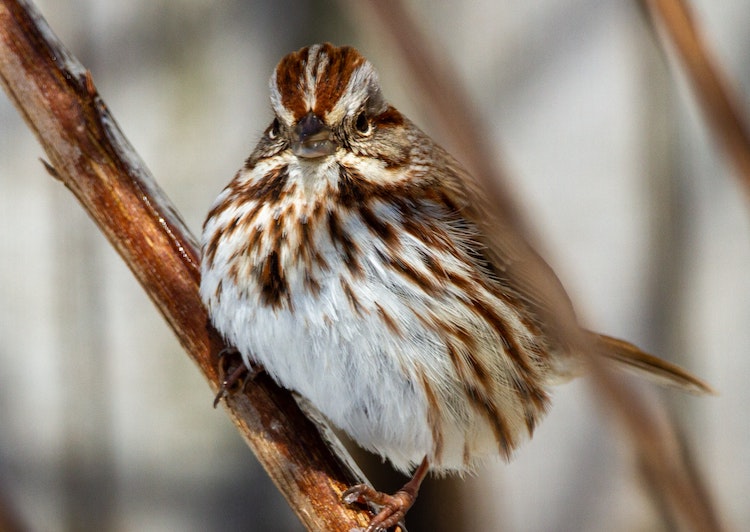
There are many types of sparrows that visit Minnesota backyards all year around, but the Song Sparrow is one of the most common backyard birds in Minnesota’s summers. If you manage to get a breeding pair on your backyard, and they like the place, they will come back year after year so it’s worth making the effort to provide good shelter. They’ll happily eat bird seed from a hooper or ground tray feeder.
Identification: If you see a sparrow like bird with streaked feathers in an open or wet area or among shrubbery, you are likely to be looking at a Song Sparrow. They range from a dark rusty color to a pale grey, and have delicate but clearly visible streaks on the sides and breast. They are plump birds with a round head, round tail and a short conical bill. Their song is stuttering and clattering, less musical than the name would have you think. They are not shy birds, and the males will sing from lower branches at human eye level but they will fly away from feeders if startled.
American Goldfinch (Spinus Tristis)
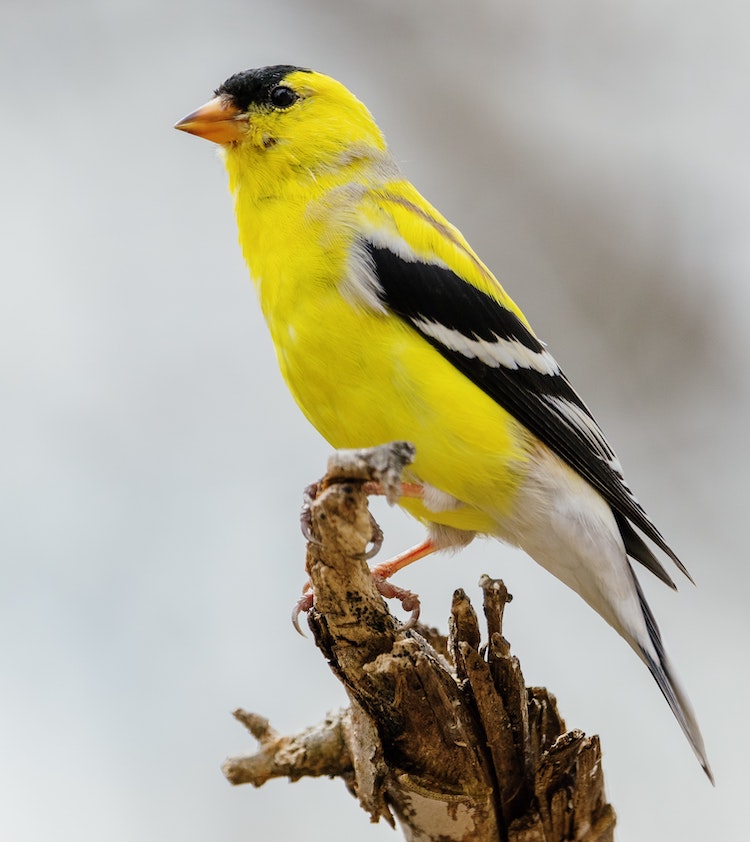
The American Goldfinch is a welcome sight when birdwatching in Minnesota. Their cheerful song and bright yellow plumage makes this bird emblematic of summer. They love thistle seeds and other similar seeds and are frequent visitors to bird feeders. If you want to attract Goldfinches to your backyard, hang a bird feeder with black sunflowers and Nyjer seeds. Just make sure to squirrel proof your bird seeder because squirrels also love that sort of food. Expect to see them starting early spring, though they won’t nest until June or July when food is abundant.
Identification: This tiny bird is known as “wild canary” for its bright yellow summer plumage, and it’s very easy to see him in weedy fields where thistles grow. In flight you can hear them singing a little lilting 4-part song that sounds like “po-ta-to-chip”. To attract their mates they have a longer, lilting melody. Non-breeding specimens are brown, but still keep a bright yellow head. Females and winter birds have a duller brown plumage, a conical bill and a notched tail. They don’t have streaks. This bird molts twice a year, so they can look pretty different depending on when you see them.
American Crow (Corvus Brachyrhynchos)
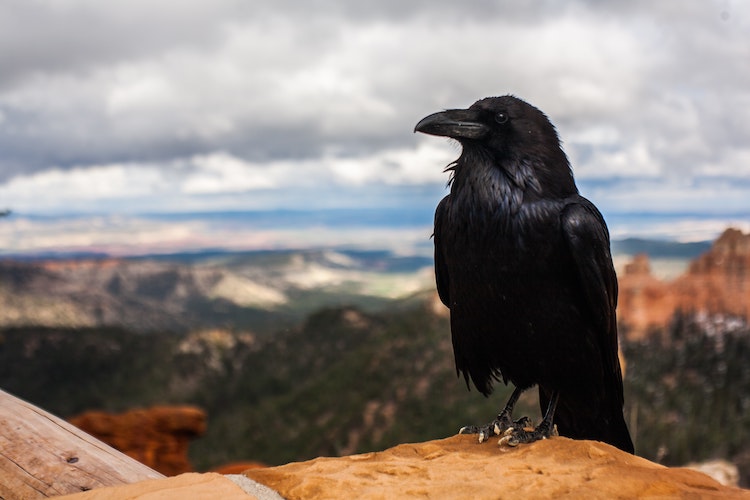
One of the largest backyard birds in Minnesota, the American Crow is smaller than its raven cousins but larger than most birds you’ll find in your backyard. They are around all year around, and will eat anything from seeds to table scraps. They are very intelligent birds that learn when food is easily available. Most people don’t really want those messy birds taking over their bird feeders, and the challenge is often keeping them out rather than attracting them.
Identification: A large, black bird about 17.5 inches from bill to tip, this bird usually moves in large flocks. They have a large head and a thick neck, and a stumpy, short tail. The bill is as long as the head.
Black-capped Chickadee (Poecile atricapillus)
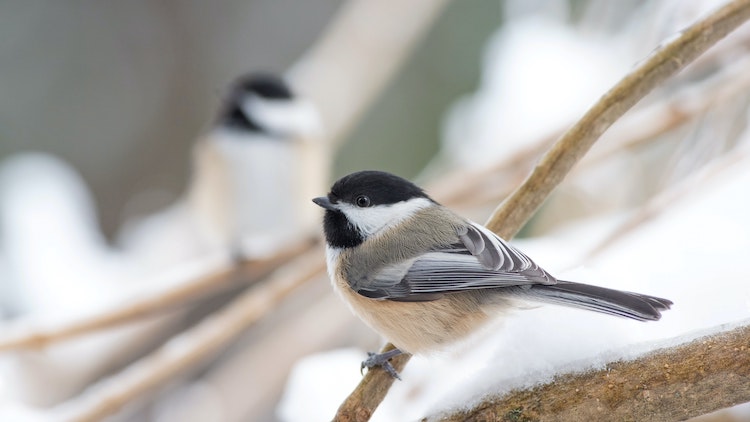
This tiny bird is common all across the northern half of the United States, and favours deciduous and mixed forests. However, they won’t hesitate to visit tube, hopper and tray feeders particularly if well stocked with black oil sunflower seeds, peanuts or suet. They are a very curious bird that will quickly investigate people (and bird feeders) in their territory, and so they are pretty easy to see. They will also visit window feeders. A well placed nesting box (install it well before breeding season) will easily attract breeding pairs. For extra chickadee point, fill it with sawdust or wood savings and make sure it’s placed in a wooded area so wrens don’t take over instead.
Identification: Black-capped Chickadees are a very cute looking bird, with an oversized round head in a tiny body the size of a Goldfinch. They are also extremely curious about humans and will most definitely watch you. they have a black cap and bib, white cheeks and a grey back, wings and tail. the underside is whitish but not bright white.
Chipping Sparrow (Spizella passerina)
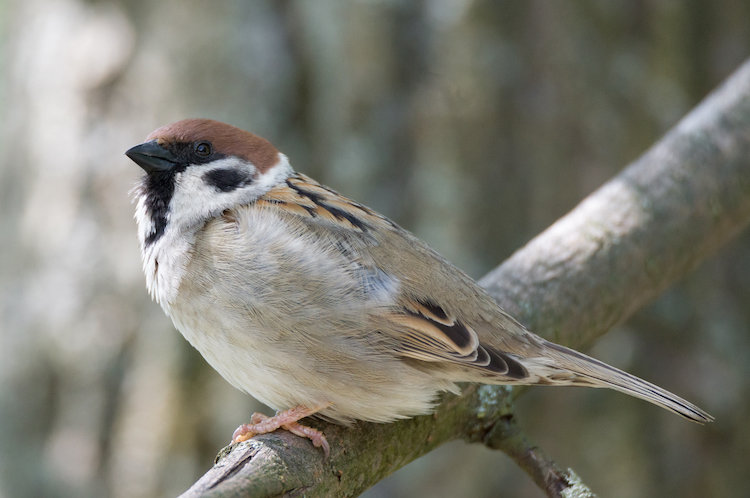
Chipping Sparrows favour small woodland areas, but they will nest in all sorts of human populated places (weirdest one probably being a hanging strand of chilli peppers getting dry). They are easy to attract to the typical Minnesota backyard with bird feeders stocked with birdseed and black oil sunflower seeds.
Identification: Adults are easy to tell from other sparrows by the bright red hat on top of their heads. They are very common, and their loud, trilling song is a frequent occurrence in woodlands and leafy suburbs. You can see them feeding in open ground near trees, while the male can often be seen singing from the upper branches of trees. In flight you can see their gray rump and plain grey belly. Non-breeding adults also have a reddish top but much duller, nearly brown. All of them have a dark line across from the beak to the back of the neck crossing by the middle of the eye.
Mourning Dove (Zenaida macroura)
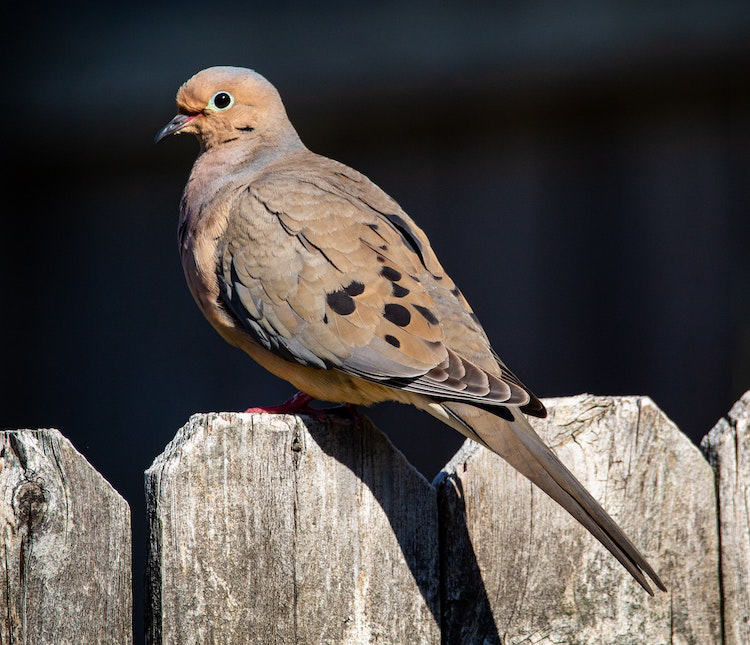
This type of dove is a common game bird and often hunted for food, so you may find attracting it to your backyard difficult as they can be weary of human populated areas. They are however a very high population bird. They perch on telephone wires, and go down to the floor (or a platform or ground feeder) to eat as many seeds as possible which they accumulate in a specially dedicated enlargement in their throat (the crop). They have big appetites and eat very messily, and are partial to millet and other small seeds.
Identification: Small, graceful and small headed dove with gray plumage on top and a distinctive pale peach colored breast and belly. Their beak is thin and black, with pinkish legs. The wings have large black spots, and make a very distinctive high-pitched whistle while flying. Their call is what gives them the name, as it sounds like a lament and they do it by puffing up their throat in a very distinctive balloon shape.
Blue Jay (Cyanocitta Cristata)
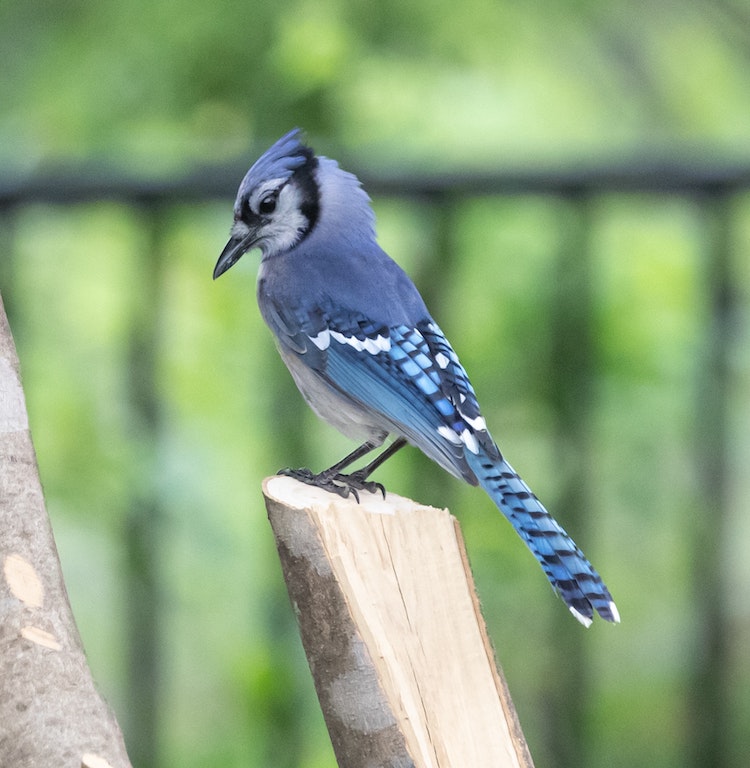
The Blue Jay is a common visitor in the entire eastern half of the United States, and it’s easy to recognize by their blue plumage. In order to attract blue jays to your garden, install a platform feeder on a pole and stock it with peanuts, sunflower seeds and suet. They also absolutely love acorns and will appreciate a bird bath. They are very intelligent birds and can learn where the best feeders are pretty easily, however they will get scared by squirrels.
Identification: The main characteristic of the Blue Jay is the bright blue top marked with black bands and a grey breast. They have a black neck collar framing the face, and a relatively long black beak. They are noisy birds that have complex social systems and family bonds, reinforced by noisy and frequent calls.
Other Common Backyard Birds In Minnesota’s Spring
Besides the last remaining winter birds and the early summer ones, you can see some birds that are particularly popular in Minnesota’s Spring season from April to May.
- Red-winged Blackbird (48%)
- Mallard (43%)
- Canada Goose (42%)
- Tree Swallow (23%)
- Brown-headed Cowbird (22%)
- Wood Duck (21%)
- Red-bellied Woodpecker (20%)
Some of those birds are just migrating on their way to somewhere else, but will take breaks in particularly suitable areas to feed and rest.
As you can see, Minnesota backyards are busy places for birds! A well placed bird feeder will offer endless hours of bird watching possibilities (you may want a pair of budget binoculars for birding) and installing bird nesting houses in winter will pay off in the breeding season with extra activity in your garden. Familiarise yourself with the most common backyard birds in Minnesota and you’ll have lots of fun all year around.
Leave a Reply